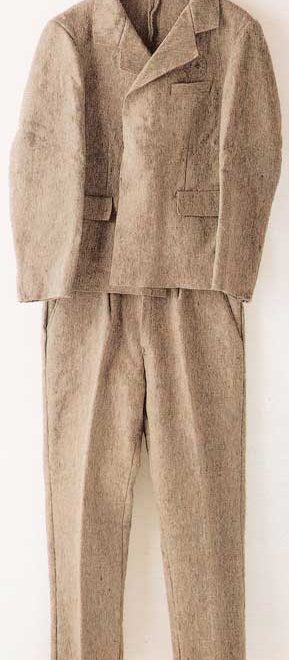Joseph Beuys
Multiples
GENERAL INTRODUCTION TO THE EXHIBITION “If you have all my multiples, then you have me entirely.” Joseph Beuys Of all the possible approaches to the work of Joseph Beuys (Krefeld 1921 – Düsseldorf 1986), the most enlightening and meaningful one is offered by his editions of objects, photographs, prints and films – in other words, his multiples. In their combinations they provide a concentration of the social and political thinking and creative activity of one of the most influential artists of the twentieth century. These groups of objects and documentary items must be considered as veritable “coded messages” which reveal and faithfully exemplify the ideas and work of this charismatic figure, especially his commitment to art capable of criticizing the art scene of his time and influencing and “healing” society. Room 1 BEUYS AS BEUYS “I am interested in the development of a real alternative to the existing systems in the West and in the East.” Joseph Beuys The philosophical and aesthetic influences of Joseph Beuys and the profound interrelationship between the life and work of this “shaman”, influential teacher, social activist and creator of forms provide the starting point for this exhibition, which reveals the key elements in an iconographic and symbolic vocabulary that confronts the Kantian tradition and establishes the theoretical basis of “social sculpture”. This room, which includes works representative of his personal mythology, such as the felt suit or the sled, shows the role that drawing played as an instrument for reflection, and it focuses on key questions such as his sacramental view of nature or his predilection for materials that could be transformed. Room 2 THE TRANSFORMATION OF ENERGY “Felt and fat are not isolated objects; in themselves they are simply batteries which radiate thermal energy. The viewer is enveloped by the reach of that thermal energy, its form. This abolishes the age-old problem of art, the separation between subject and object, not de facto but in the experience of reception …” Joseph Beuys A vital feature in Joseph Beuys’s artistic aims is the idea of the transformation of energy as an analogy of society’s capacity for change and healing, his most cherished undertaking. He used warm materials such as fat, honey, wax, oil or metal, which change when exposed to heat, not only to show his rejection of the idea of art as merchandise but also because of their suitability for representing transmission and reception as a natural phenomenon comparable to social processes. In these works Beuys identifies man as the activator of society’s consciousness of its time. Room 3 DEFENCE OF NATURE “Our relationship with nature is characterized by the fact that it is a thoroughly disturbed relationship. The result of this is that the natural foundation on which we depend is not only disturbed but is in danger of being completely destroyed. We are well on the way to destroying that basis completely by working with an economic system that is founded on unrestrained exploitation of that natural basis. Brutal exploitation is the obvious consequence of an economic system in which making a profit is the supreme guiding principle.” Joseph Beuys Most of the works exhibited in this room document actions which Joseph Beuys performed in the natural environment. His actions are directly connected with the emergence of ecological awareness and with his view of nature as a spiritual substance, and they often take on a theatrical quality, such as when we find him sweeping a forest. The use of basalt and of spades and other agricultural implements, the inclusion of animals such as the hare (in which he saw himself) and the value he attached to trees, plants and, once again, natural substances such as water, oil or wine give his work an ethical dimension that goes beyond the bounds of art. Room 4 BEUYS AS A SOCIAL REFORMER “It is simply about this principle which is still too difficult for many people to understand, that art can no longer be art now if it does not get to the heart of our existing culture and bring about a transformation there […].” Joseph Beuys All Beuys’s theories about art, his social ideas and his sculptural research come together in his most striking ideological undertaking: the expansion of individual consciousness by a collective commitment summed up in the maxim that “everybody is an artist”. His opposition to political forces by means of intellectual activities (writing, teaching, giving talks and so on) explains the extensive use of magazines, newspapers and printed “promotional” material in his work and justifies the introduction of the economic variable which determines the balance of forces in society. Room 5 BEUYS AS ACTOR (PERFORMER) AND SPEAKER “For me, language is obviously the first kind of sculpture. One shapes thoughts in a medium of expression. The medium of expression is itself the language. One must learn to look at thinking in this way; people must learn to consider it as an artist looks at his work, considering its form, its proportions and its strength.” Joseph Beuys This room is directly connected with the previous ones, functioning as a compendium in which we find some of the most valuable testimonies of Joseph Beuys’s activity, life and work: his films. His concerts, conversations and sit-ins, his cultural references, his personal view of the art world and also memories of those he admired (such as the film maker Ingmar Bergman, his friend Klaus Staeck, the publisher, or the Korean artist Nam June Paik) provide a conclusion for this exhibition, which sets out to accomplish a profound observation of the world of this artist who made his work a veritable “mission”.



